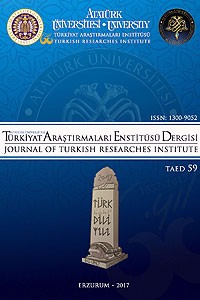Abstract
Kronolojik açıdan çok eski bir tarihe sahip olmak sanat, kültür ve medeniyet alanlarında zengin bir birikimi ortaya çıkarmaz. Somut kültürel öğelerinin yanında somut olmayan kültürel öğelerin zenginliği bir toplumu güçlü kılan unsurlardan sayılmaktadır. Somut kültürel öğelerin, ayrıntılı anlam ve kavram bütünlüğü içinde ifade edilmesi, medeniyetin yüksekliğini gösteren önemli ilkelerden biri olmaktadır. Türklerin göçebe hayat tarzından yerleşikliğe, Şamanizm, Budizm, Maniheizm’den İslam’a geçişle çok zengin somut olmayan bir kültür birikimini edinmelerine imkân tanımıştır. Somut olmayan kültür birikiminin büyük çoğunluğu dile aittir. Söze ve kelimeye dayanan bu kavramlar yazılı hale getirilmişse kalıcılığı ve kuşaktan kuşağa aktarımı daha sağlıklı ve kolay olabilmektedir. Türklere ait yazılar miladi yıllara kadar gidebilse de kitap diyebileceğimiz materyaller ele geçen belgelere göre Uygurlar ile başlamaktadır. Uygurlardan sonra kültür ve medeniyet birikimini devralan Karahanlılar Türk İslam medeniyetinin kurucusu olarak kabul edilir. Karahanlılar devrinde kaleme alınan Dîvânü Lügati’t-Türk sanat ve sanat terminolojisi açısından incelendiğinde Türklerin oldukça gelişmiş bir sanat kavramına sahip olduğu görülecektir. Bu kavramsal zenginlik günümüz sanat terminolojisinin zenginleşmesine kaynaklık edebilecek bir mahiyete sahiptir.
References
- Barışta, H. Örcün. (1984). “Dîvânü Lügati’t-Türk’te Dokuma ve Dokumanın Üzerine Yapılan Bezemeler Çerçevesinde Kümelenen İfadeler”, 9 Eylül Üniversitesi II. Ulusal Sanatlar Sempozyumu Bildirileri 1982, İzmir.
- Ekiz, Mehmet. (2012). “Dîvânü Lügati’t-Türk’te Yer Alan Mimari Terimler Üzerine”, Turkish Studies - International Periodical For The Languages, Literature and History of Turkish or Turkic, Volume 7/4, Fall p. 1681-1690, Ankara.
- Erdi, Seçkin ve Yurtsever, Serap, Tuğba. (2005). Dîvânü Lügati’t-Türk, İstanbul: Kabalcı Yayınevi.
- Genç, Reşat. (1998). “Kaşgarlı Mahmut’a Göre XI. Yüzyılda Türklerde Dokuma ve Yaygı İşleri”, Türk Soylu Halkların Halı, Kilim ve Cicim Sanatı Uluslararası Bilgi Şöleni Bildirileri, 27-31 Mayıs 1996 Kayseri, Atatürk Kültür Merkezi Yayınları, Ankara.
- Kültüral, Zuhal. (2009). “Sözlük Bilimi Açısından Dîvânü Lügati’t-Türk”, Turkish Studies - International Periodical For The Languages, Literature and History of Turkish or Turkic, Volume 4/4, p. 805-813, Ankara.
- http://www.tdk.gov.tr/?option=com_dlt&view=dlt&kategori1=kasgarli2 (erişim tarihi 19.01.2016, saat: 14:10).
- Üşenmez, Emek. (2016). Terimsel Açıdan Dîvânü Lügati’t-Türk, http://www.emekusenmez.com/2013/03/12/terimsel-acidan-divanu-lugatit-turk/,s. 2. (Son Erişim Tarihi: 19.01.2016)
Abstract
Having a long history chronologically for a strong society is not enough. Besides, it must have a history of society's material and spiritual heritage enriched by the accumulation, and it must be the concepts of these tangible works can be considered expressing spiritual civilization. One important principle is showing the height of culture for detailed meaning and expression in the concept of integrity of the material civilization of the items. The transition from nomadic life style to sedentay life style and from Shamanism, Buddism, Maniheism to Islam, constitute a particular advantage over its term which bringing a rich tangible cultural accumulation.It belongs to language the vast majority of tangible cultural accumulation. It can be easy and healthy to transfer from a generation to generation if these concepts was writen that they were based on words and phrases. Although the writings of the Turks can go as far as the millenniums, the materials that we can call the book are starting with the Uighurs according to the documents found. Karahanid, who took over the accumulation of culture and civilization after the Uygurs, is accepted as the founder of the Turkish Islamic civilization. The Diwan-ı Lugati’t-Turk that was writen on the period of Karahanid, was examined for terms of art and art terminology, the Turks will be seen to have a highly developed art concepts. This wealth has a nature cabaple source for contemporary art terminology to enrichment.
References
- Barışta, H. Örcün. (1984). “Dîvânü Lügati’t-Türk’te Dokuma ve Dokumanın Üzerine Yapılan Bezemeler Çerçevesinde Kümelenen İfadeler”, 9 Eylül Üniversitesi II. Ulusal Sanatlar Sempozyumu Bildirileri 1982, İzmir.
- Ekiz, Mehmet. (2012). “Dîvânü Lügati’t-Türk’te Yer Alan Mimari Terimler Üzerine”, Turkish Studies - International Periodical For The Languages, Literature and History of Turkish or Turkic, Volume 7/4, Fall p. 1681-1690, Ankara.
- Erdi, Seçkin ve Yurtsever, Serap, Tuğba. (2005). Dîvânü Lügati’t-Türk, İstanbul: Kabalcı Yayınevi.
- Genç, Reşat. (1998). “Kaşgarlı Mahmut’a Göre XI. Yüzyılda Türklerde Dokuma ve Yaygı İşleri”, Türk Soylu Halkların Halı, Kilim ve Cicim Sanatı Uluslararası Bilgi Şöleni Bildirileri, 27-31 Mayıs 1996 Kayseri, Atatürk Kültür Merkezi Yayınları, Ankara.
- Kültüral, Zuhal. (2009). “Sözlük Bilimi Açısından Dîvânü Lügati’t-Türk”, Turkish Studies - International Periodical For The Languages, Literature and History of Turkish or Turkic, Volume 4/4, p. 805-813, Ankara.
- http://www.tdk.gov.tr/?option=com_dlt&view=dlt&kategori1=kasgarli2 (erişim tarihi 19.01.2016, saat: 14:10).
- Üşenmez, Emek. (2016). Terimsel Açıdan Dîvânü Lügati’t-Türk, http://www.emekusenmez.com/2013/03/12/terimsel-acidan-divanu-lugatit-turk/,s. 2. (Son Erişim Tarihi: 19.01.2016)
Details
| Journal Section | Makaleler |
|---|---|
| Authors | |
| Publication Date | May 31, 2017 |
| Published in Issue | Year 2017 Issue: 59 |


